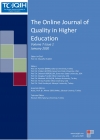TOJQIH - Volume 5 - Issue 1 - January 2018
 EFFECTIVENESS OF USING STOP, THINK AND TALK ACTIVITIES ON THE PERFORMANCE OF STUDENTS IN READING COMPREHENSION IN JUNIOR SECONDARY SCHOOLS IN FEDERAL CAPITAL TERRITORY (FCT) ABUJA
EFFECTIVENESS OF USING STOP, THINK AND TALK ACTIVITIES ON THE PERFORMANCE OF STUDENTS IN READING COMPREHENSION IN JUNIOR SECONDARY SCHOOLS IN FEDERAL CAPITAL TERRITORY (FCT) ABUJA Hanna Onyi YUSUF
Abstract:
The study was carried out to determine the effect of stop, think and talk activities on the performance of students
in reading comprehension in junior secondary schools in Federal Capital Territory (FCT) Abuja. The study was
carried out using a quasi-experimental pretest-posttest research design. The target population of the study
comprised of 16,925 JSII students. A sample size of 100 JSII students from two secondary schools in the Federal
Capital Territory (FCT) Abuja, were purposely sampled in the study. Sixty five (65) students from Government
Junior Secondary School, Apo and thirty five (35) from Government Junior Secondary School, Garki were used
for the study. Both groups of students were taught for six (6) weeks. Government Junior Secondary School, Apo
was assigned as the experimental group while Government Junior Secondary School, Garki was assigned as the
control school. Students were pre-tested to establish their homogeneity before the commencement of the
treatment. They were taught for six (6) weeks and were tested using retelling test as an instrument. Data
collected from students’ test scores was analysed using mean and standard deviation, while t-test was used to test
the formulated null hypothesis at 0.05 level of significance. Findings of the study revealed that “stop, think and
talk” activities had significant effect on students’ performance in reading comprehension. In fact, the
experimental group which was exposed to stop, think and talk activities had better understanding of the reading
comprehension passages given to them. The result further revealed that students in experimental group were
more active, responsive and paid more attention to details concerning the main ideas in the passages read. Based
on the findings, it was recommended that teachers should be encouraged to use “stop, think and talk” activities in
reading comprehension lessons. Such activities should be provided before, during and after every reading
comprehension passage to enhance and facilitate students’ reading abilities. Curriculum planners should provide
activities that would encourage students to “stop, think and talk” to make reading comprehension lesson more
purposeful and meaningful.
 INFLUENCE OF SOCIO-CULTURAL FACTORS ON RURAL HOUSE FORM IN TARABA STATE OF NIGERIA
INFLUENCE OF SOCIO-CULTURAL FACTORS ON RURAL HOUSE FORM IN TARABA STATE OF NIGERIA Adadu Ochapa, Eyiaromi Ademileke Folorunsho
Abstract:
This study investigates the Influence of Socio-Cultural factors on Housing Form in Rural Environment Among
various ethnic groups of Taraba State, Nigeria with the aim to understand the socio-cultural factors that
influences housing form adopted by tribes. A population of 2,300,736 (NPC, 2006) and a sample size of 750
house-hold head were selected for this study comprised of 135(18%) Mumuye, 86(11.47%) Jukun, 120(16%)
Tiv, 95(12.67%) Mambila, 175(23.33%) Fulani, 105(14%) Wurukum and 34(4.53%) belong to other minority
tribes. A Multistage Sampling technique was employed in the process of data collection. The study is a
descriptive survey design with the main instruments used in collecting the data was “Questionnaire and in-depth
interview (IDI) with a reliability index of 0.818 and validity of 0.90. Results are presented using simple
percentage and the hypothesis was analyzed using chi-square statistics. The findings revealed that Traditional
Single Hut Form (TSHF) is synonymous to Mumuye ethnic group belongs to low income class, while
Traditional Compound Form (TCF) is synonymous to Jukun and Fulanis ethnic group belongs to low and
middle income classes. The Fulani ethnic group were the majority in the use Jointed Block of Traditional Form
(JBTF) and Jointed Block of Modern Building Form (JBMBF) of middle income classes. This study area socioeconomic
activity is agrarian in nature; Mumuye ethnic groups were the majority in food crop farming followed
by Tiv and Mambila ethnic group. Tiv ethnic group are the majority in cash crop farmland followed by Jukun
ethnic group, The Fulani ethnic dominated the animal husbandry (pastoral Farmland), while Fish farming was
dominated by Wurukum ethnic group. The hypothesis revealed that Housing forms are not the same among the
various ethnic groups in the study area. The researchers therefore recommend that when Wurukum tribe in any
part of the country need to be resettled by government it should be near fishing water source, Fulanis near
grassing field, Mumuye, Tivs and Mambila ethnic groups near farmable land.
 INTERNET FACILITIES UTILISATION AND UNDERGRADUATE STUDENTS ACADEMIC PERFORMANCE OF FEDERAL COLLEGES S OF EDUCATION IN NORTH CENTRAL NIGERIA
INTERNET FACILITIES UTILISATION AND UNDERGRADUATE STUDENTS ACADEMIC PERFORMANCE OF FEDERAL COLLEGES S OF EDUCATION IN NORTH CENTRAL NIGERIA EMMANUEL NANNIM RAMSON, DANJUMA GOKUM KATKUKAH, AJAYI DANIEL OLUWAFEYIKEMI
Abstract:
The study was an assessment of undergraduate students utilization of internet facilities for academic purpose in the
Federal Colleges s of Education in North central Nigeria. In achieving the goals of the study, four research questions
and two hypotheses were raised. The study employed the cross-section survey research design approach in which
both descriptive statistics and the Pearson-chi-square statistical tools were used in analyzing the research questions
and hypotheses raised. The study also used the questionnaire for internet users (QIU) as tool for data collection from
the sample of NCE and B.Ed undergraduate students of F.C.E. in North central Nigeria to which the stratified
random sampling technique was employed in selection of respondents. Results of data analysis from the study shows
that there is a significant difference in the internet literacy/exposure level; amount of time spent on the internet for
academic purpose; and extent of utilization of internet facilities for academic purpose among the NCE and B.Ed
undergraduate students of the Federal Colleges s of Education in North central Nigeria.
 QUALITY MANAGEMENT IN HIGHER EDUCATION ADMISSION SYSTEM
QUALITY MANAGEMENT IN HIGHER EDUCATION ADMISSION SYSTEM Mengmeng Chen
Abstract:
The industry of higher education institutions such as colleges and universities are highly competitive amongst
themselves for the best students, professors, researchers, industry partners, and athletic programs. Charged with
attracting top quality clientele who will not only attend the institution, but help the university reach its objectives
and goals, the marketing department becomes paramount to the organization’s success.
For many years higher institution attendance has increased across the board. As more technical colleges and
alternative career paths with specialized training become more appealing, statistical analysis indicates that higher
institution attendance numbers are decreasing. If this trend continues, colleges and universities will be forced to
become more competitive to entice high quality clientele to attend their organization. The importance of
marketing the institution will become critical to ensure the continued success of the organization.
Higher education institutions can target ideal candidates for their university’s programs through the use of
statistical analysis techniques such as lead scoring, time series control, continuous improvement, and quality
management tracking. Considered quality leads, ideal candidates possess a high likelihood of attending the
university and garnering greater returns for the university through academic or athletic achievement.
 THE DEVELOPMENT OF COMPETENCES OF NURSING STUDENTS DURING THEIR FIRST PRACTICAL CLASSES
THE DEVELOPMENT OF COMPETENCES OF NURSING STUDENTS DURING THEIR FIRST PRACTICAL CLASSES Iwona Bodys-Cupak, Alicja Kamińska, Anna Majda, Joanna Zalewska-Puchała
Abstract:
Nursing education devotes a lot of attention to the development of competence. The character and quality of
students’ clinical experience, in addition to knowledge, play an important role in this process. Nursing students’
first experiences during the development of competence during the practical classes on the ward after
practicingprofessional skills in simulated conditions is of utmost importance. The aim of this study was to assess
the development of competence of nursing students during the first practical classes.
The study utilised a diagnostic survey and rating scales. The research tools included: an original questionnaire
and ACS - Ascent to Nursing Competence Scale. The subjects were 322 first year undergraduate nursing
students from universities in southern Poland. The fieldwork was carried out in 2016, after the students had
completed their first block of practical classes.
Students rated their competence in the area of Knowledge and Skills as the highest, and their competences in the
area of Need to belong to a group as the lowest. Younger students achieved higher scores in all subscales of the
competence scale.
Supportive learning environment facilitates the development of competence of nursing students. The sense of
self-efficacy and the sense of belonging to an interdisciplinary team of learners play a crucial role in this
process.


